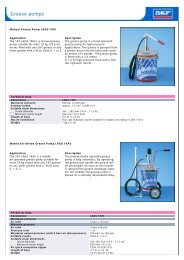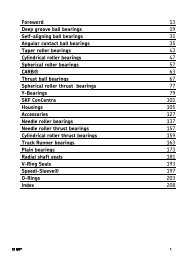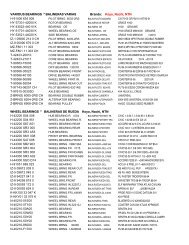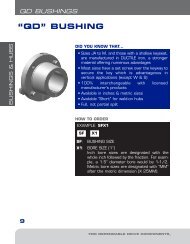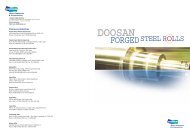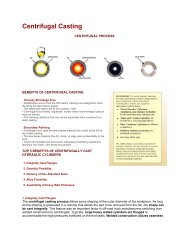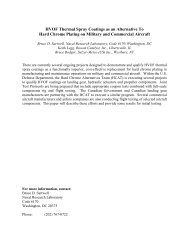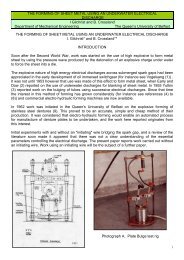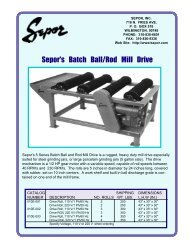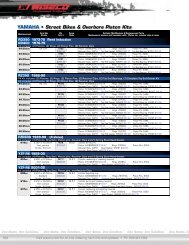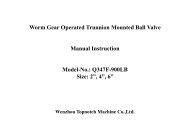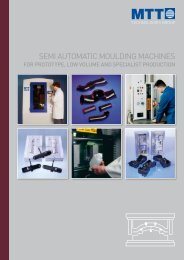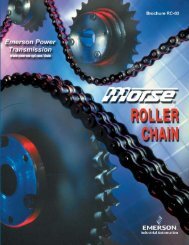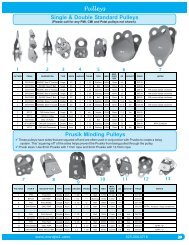Plastic Blow Molding
Plastic Blow Molding
Plastic Blow Molding
You also want an ePaper? Increase the reach of your titles
YUMPU automatically turns print PDFs into web optimized ePapers that Google loves.
<strong>Plastic</strong> <strong>Blow</strong> <strong>Molding</strong><br />
Training Objective<br />
After watching this video and reviewing the printed material, the<br />
student/trainee will gain a knowledge and understanding of the blow molding<br />
process and its basic variations.<br />
• The basic blow molding process is described.<br />
The processing of parisons and preforms are detailed.<br />
Continuous and intermittent molding is explained.<br />
The biaxial and co-extrusion methods are discussed.<br />
<strong>Plastic</strong> <strong>Blow</strong> <strong>Molding</strong><br />
These processes represent the most popular way of producing hollow products<br />
such as bottles, drums, and other vessels out of thermoplastic materials.<br />
This modern industrial technology has evolved from the ancient art of glass<br />
blowing. Among the many types of resins used are:<br />
various densities of polyethylene<br />
polyethylene terephthalate polypropylene<br />
polyvinyl chloride<br />
thermoplastic elastomers<br />
polystyrene<br />
fluoropolymers, and many others<br />
The principle process is “extrusion blow molding.” Others include injection<br />
blow molding, biaxial stretch blow molding, and co-extrusion blow molding.<br />
All of which utilize elements of either extrusion or injection, or both. All<br />
of the processes share distinct production stages:<br />
plasticizing or the melting of resin<br />
parison production which refers to most blow molding operations; or preform<br />
production when referring to biaxial stretch blow molding<br />
inflation and cooling phases in the mold<br />
ejection from the mold<br />
A fifth stage required in extrusion blow molding involves trimming the final<br />
product.<br />
Process Operation<br />
The same blowing technique is common to all the process variations and is<br />
accomplished through either a blow pin, needle, stuffer, or a core rod.<br />
The process begins with applications of heat and pressure to create the<br />
“melt.” The melt is then processed through a reciprocating screw and ram<br />
assembly that pushes the material through a die to produce the “parison.”<br />
This production of the parison may be continuous or intermittent and is<br />
similar to the injection molding process. The reciprocal screw, which heats<br />
and moves the resin, has feed, compression, and metering zones. Once the<br />
proper amount of melt is available, a ramming action delivers the material to<br />
the die and forms the parison. In the case where very large parisons need to<br />
be formed, an accumulator type of machine is used. This is reservoir system,<br />
Fundamental Manufacturing Processes Video Series Study Guide -1-
<strong>Plastic</strong> <strong>Blow</strong> <strong>Molding</strong><br />
which allows a melt delivery rate independent of the screw and ramming<br />
sequences.<br />
In the continuous extrusion form of blow molding. The screw does not<br />
reciprocate, but continues turning and thus continuously delivers melt to the<br />
head and die assemblies, forming a continuous parison. Most extruder head and<br />
die assemblies are known as the “cross head” type which divert the flow of<br />
the resin from horizontal to vertical. Crossheads may either be center-feed<br />
or side-feed. The center-feed design produces a uniform flow downward around<br />
the tip of conical core or mandrel and results in a straight flow all around<br />
the mandrel. Side-feed assemblies force the resin around the perimeter of the<br />
mandrel and then extruded through the die as a parison with varying wall<br />
thickness’. To control the parison’s temperature and wall thickness, a<br />
programmer is used.<br />
While the intermittent extrusion system is able to produce a wide range of<br />
products, the continuous system uses several process variations that widen<br />
the product range even further. These include the shuttle or reciprocating<br />
blow molding system and the rotary wheel blow molding system.<br />
The shuttle system uses multiple molds and so requires multiple parisons. To<br />
accomplish this a manifold is used to distribute the melt to several dies at<br />
once as the parisons arrive at the molds blow position. A cutting device<br />
separates the required portion of the continuous parison, a blow pin or<br />
needle is inserted in the parison and with a jet of air the product is blown<br />
into shape. For high volume production, 20 or more split molds can be mounted<br />
on a horizontal turntable or vertical rotary wheel for continuous molding.<br />
Injection blow molding utilizes elements of conventional thermoplastic<br />
injection molding. This is more economical than the extrusion process and<br />
generally is used for large production quantities of smaller containers of<br />
less than liter size. Basically, the systems include an injection station, a<br />
blow station, and a strip or eject station.<br />
Biaxial Stretch and Co-Extrusion <strong>Blow</strong> <strong>Molding</strong><br />
These advanced processes have developed in response to market demands and the<br />
newer resins available. Biaxial blow molding uses polyethylene terephthalate<br />
or PET. and is the second most widely used blow molding process and produces<br />
a container by stretching either a preform or parison in both axial and<br />
radial directions. This stretching increases the materials strength clarity<br />
and barrier properties while reducing material consumption. This method can<br />
be used with several resin types and produces the bulk of soft drink<br />
containers. The single stage version of the process produces the container<br />
within one machine with multiple stations. As a two-stage operation, it is<br />
similar to the single stage method except that a preform is produced by a<br />
injection molding machine independent of the stretch blow molding machine.<br />
Co-extrusion blow molding produces containers with multiple wall layers.<br />
These layers can be clear, colored, virgin, or recycled material. The<br />
different layers are extruded together and simultaneously in the head and die<br />
assembly before their extrusion as a parison. Products produced may have from<br />
just two to as many as seven layers. Typical products include fuel tanks,<br />
motor oil containers and condiment bottles.<br />
Fundamental Manufacturing Processes Video Series Study Guide -2
<strong>Plastic</strong> <strong>Blow</strong> <strong>Molding</strong><br />
Fundamental Manufacturing Processes Video Series Study Guide -3-
<strong>Plastic</strong> <strong>Blow</strong> <strong>Molding</strong><br />
Review Questions<br />
1. <strong>Blow</strong> molding uses resins that are called:<br />
a. plastics<br />
b. PVCs<br />
c. thermoplastics<br />
d. polymers<br />
2. The basic blow molding process is built upon:<br />
a. compression<br />
b. extrusion<br />
c. drawing<br />
d. spinning<br />
3. The function of the “needle” is to:<br />
a. inflate the melt<br />
b. meter the melt to the die assembly<br />
c. control the movement of the screw<br />
d. control die cooling<br />
4. After the resin is forced through the die and crosshead assembly, it is<br />
called a:<br />
a. melt<br />
b. parison<br />
c. draw<br />
d. flow<br />
5. In the continuous mode of extrusion blow molding, the screw:<br />
a. automatically reverses direction<br />
b. pumps laterally back and forth<br />
c. is computer controlled<br />
d. rotates in one direction<br />
6. An accumulator system is used to produce parisons that are:<br />
a. very small<br />
b. very large<br />
c. thicker<br />
d. thinner<br />
7. Multiple parisons are produced in:<br />
a. the injection molding phase<br />
b. the “shuttle” variation of the process<br />
c. the center feed crosshead<br />
d. the intermittent type of blow molding<br />
8. Smaller containers are produced by:<br />
a. injection blow molding<br />
b. continuous blow molding<br />
c. rotary blow molding<br />
d. biaxial blow molding<br />
9. The resin used to produce soft drink containers is called:<br />
a. PVC<br />
b. THI<br />
c. PET<br />
d. FPO<br />
Fundamental Manufacturing Processes Video Series Study Guide -4-
<strong>Plastic</strong> <strong>Blow</strong> <strong>Molding</strong><br />
10. Co-extrusion blow molding is used to produce:<br />
a. clear containers<br />
b. large containers<br />
c. multilayered containers<br />
d. heavy wall containers<br />
Fundamental Manufacturing Processes Video Series Study Guide -5-
<strong>Plastic</strong> <strong>Blow</strong> <strong>Molding</strong><br />
Answer Key<br />
1. c<br />
2. b<br />
3. a<br />
4. b<br />
5. d<br />
6. b<br />
7. b<br />
8. a<br />
9. c<br />
10. c<br />
Fundamental Manufacturing Processes Video Series Study Guide -6-



